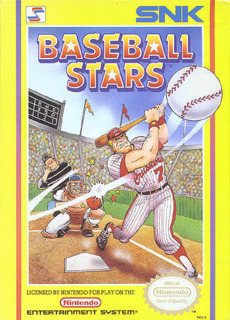The game which paved the way for deeper baseball games.
Baseball Stars has all the features you'd expect from a typical baseball game but adds depth that has not been seen in many NES games. Several modes are included, such as season, exhibition, and create a team. The game fictitious players and teams but you have the ability to customize the team names, logos, and even the player's names. Hate someone at school or in your job? Just rename your player and fire that player the same day!
Baseball Stars uses the battery-saved game feature prevalent in some of Nintendo's bigger cart-based games (i.e. Zelda). It introduces an RPG characteristic - winning games led to winning team money. The amount being won is dependent on the "Prestige" ratings of all the players. Prestige is similar to popularity. The more popular the player, the more people attend. The money can then be used to buy upgrades for your roster or used to shop around in the free agency pool which contains female baseball players - a first in baseball games. Some baseball players can have a high level of "Prestige" but not have the athletic ability to reflect it. Go figure.
Baseball Stars big trump card that sets itself apart from other baseball games is its League Play. In League Play you can be pitted against a set of teams that can be created from scratch or a pre-set number of teams already included in the game. In fact, you can even have friends have their own teams created within the same league and go head-to-head with your own players. Put your girlfriend's name on your best female pitcher and strikeout your friend's ex-roommate.
In the gameplay department, Baseball Stars is an extremely hands-on baseball game that really puts your reflexes and timing skills to the test - especially fielding. The game's batting and pitching interface are fairly standard systems that give you control of the batter's stance and swing. To get a hit you simply line up your batter and time your swing just right to make contact with the ball. The "batting area" for each batter is determined by the batter's hitting stats which makes your chances of hitting the ball realistic for each batter. Pitching is simplified to 3 types of pitches: Fastball, Curves, and the wicked "Drop" Sliders. Baseball Stars calls this pitching stat "Drop". It is essentially is a "Drop Ball," which drops around the plate almost or to the ground and goes under the bat of a swinging player. This is a great pitch during head-to-head matches.
In fielding, you can slide and jump for the ball. In some cases, you can even rob a home run by timing your climb on the stadiums wall assuming, of course, the ball is within reach. The fielding mechanic is one of the most fluid of its type and many other NES games have tried to imitate.
Controlling the base runners on the base paths is also fairly easy to do, choose the direction of a base and press "A" or "B" to advance or return to the previous base. The runners can also be individually advanced to get a quick step to the next base. While controlling multiple people on the base may be confusing, the learning curve is not steep.
The computer AI is even fairly intelligent on the game's weaker teams, but play the American Dreams where the players are named after its real-life legendary players and it's almost impossible to beat.
However, once your team has gone through considerable upgrades the real fun begins. You can begin seeing players slide miles across the field to make catches, pitchers at 100mph, and batters hitting home runs in their sleep. Baseball Stars is not a sim by any means and the scoring can get outrageous but its great fun especially when playing head-to-head.
Graphically, Baseball Stars has a very basic, clean look to the game. There are no variations to the stadiums nor are there any variations to the grass, your uniforms (aside from selecting colors), etc. The only variations that keep the game from a complete vanilla-like appearance are the pitchers and batters in the batting screen. The programmers have decided to treat gamers with different pitching and batting stances. You can expect to see side-arm pitching, low batting stances and everything in between. However, despite the lack of variations, the animations and fluid gameplay help a very plain-looking game feel much more exciting. Sound is standard fare and you may find yourself humming to some of the short list of battle songs echoed in the game. It's a far cry from it's NeoGeo version but it's obvious that the emphasis behind Baseball Stars is its gameplay and feeling of grooming your own baseball team to play against others.
Considering that NeoGeo's version of Baseball Stars is well known for its cinematics, music, and colorful commentary, the NES version has put team management, customization, and fluid gameplay as its emphasis. when it comes to features included in a sports game, it's odd that other baseball games that debuted after Baseball Stars are limited in depth and in gameplay. The truth is that even if you look at Baseball Stars purely from the standpoint of an arcade style baseball game, where you're going to get more games with double digit scoring than not, it is a game that is both very fun and engaging.
radcastro.com

